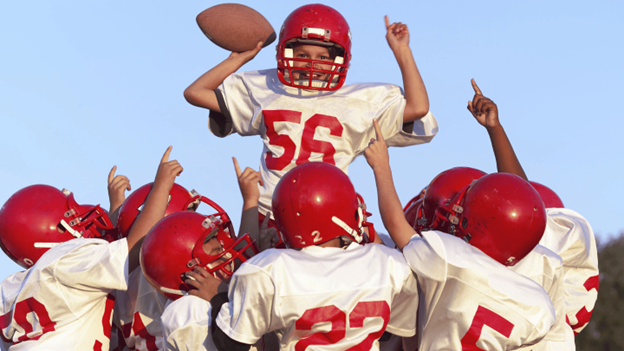
Football injuries in kids: hamstring strains, groin pulls and more.
Friday night under the lights and your young football player is having the game of their life. Then it happens: they plant their foot wrong making a cut and suddenly they're down on the field holding their leg. The coach helps them to the sideline, but now you're wondering, how serious is this football injury?
Youth football brings excitement, teamwork, and, unfortunately, a fair share of injuries. High school football has one of the highest injury rates of any sport, with hamstring strains, groin pulls and other muscle injuries being incredibly common during the season.
The key is knowing which sports injuries you can manage at home and which ones need professional care.
Most common football injuries in kids.
Hamstring strains.
Hamstring strains top the list of football injuries in kids. These happen when the muscles on the back of the thigh get stretched too far or tear slightly.
Players often describe it as a sudden "pop" or sharp pain while running.
Groin pulls.
Groin pulls are another frequent problem. The muscles on the inside of the thigh get overstretched, usually during quick direction changes or when kicking the football.
Ankle sprains.
Ankle sprains happen when players get tackled awkwardly or step wrong while running. The ankle rolls to one side, stretching or tearing the ligaments that hold the joint together.
Other common issues include shoulder injuries from tackles, knee problems from getting hit from the side and various bumps and bruises that come with contact sports.
Most of these injuries aren't serious emergencies, but they do need proper care to heal correctly and prevent bigger problems down the road.
Football injury prevention: gear, training and safety tips.
Preventing football injuries requires attention to equipment, physical preparation and smart playing techniques.
Proper equipment and gear.
Equipment makes a huge difference in preventing football injuries. Make sure your child's helmet fits correctly and isn't cracked or damaged.
Shoulder pads should cover the right areas without being too loose or too tight.
Don't forget about the basics: proper cleats for field conditions, a good mouthguard and making sure all gear is in decent shape.
Conditioning and warm-up routines
Physical preparation prevents many muscle injuries:
- Start with basic moves like leg swings, high knees and butt kicks before every practice
- Build up intensity slowly so muscles have time to get loose and blood flowing
- Work on leg and core strength during the off-season when there's more time
- Keep them hydrated before practice, during breaks and when they're done
Safe football playing techniques.
Coaches should teach proper tackling form, emphasize heads-up football to prevent concussions and make sure players know how to fall safely.
Good technique protects both your child and other players on the field.
Rest and recovery for football injuries.
Young athletes need time between intense practices, enough sleep each night and breaks during long practice sessions.
Listen to your child when they say something hurts - playing through pain often makes football injuries worse and just makes recovery times longer.
When football injuries in kids need urgent care vs. emergency treatment.
Knowing the right level of care helps you respond quickly and appropriately when your young athlete gets hurt.
When to handle football injuries at home.
You can often manage minor football injuries with basic first aid.
Opt for home treatment when the injury seems minor and your child can still walk normally, swelling and pain are mild and they can move the injured area without severe discomfort.
Ice, rest and over-the-counter pain relievers often help with minor sprains and muscle strains.
Visit urgent care for football injuries in kids.
Moderate football injuries that need medical attention but aren't emergencies are perfect for urgent care at CityMD:
- Injuries that aren't improving after a day or two
- Suspected fractures in fingers or toes
- Cuts that might need stitches
- When you're unsure about severity but don't think it's an emergency
Go to the emergency room for an injury.
Some injuries require immediate hospital care.
Head to the ER for suspected concussions with confusion, nausea, or dizziness, obvious broken bones or joints that look out of place, severe pain that doesn't improve with rest, or any injury where your child seems seriously hurt or scared.
Call 911.
True emergencies need paramedic response if your child loses consciousness, has trouble breathing, shows signs of serious head or neck injury, or if you're genuinely worried about their safety.
Sports injuries aren't the only thing that'll have you wondering if you need medical help. Check out our health and wellness blog for advice on everything from those mystery fevers to knowing when urgent care makes sense.
Keeping young athletes safe and strong at CityMD.
Football injuries in kids are common, but most heal well with proper care and attention. Understanding the difference between minor strains and serious injuries helps you respond appropriately when your young athlete gets hurt.
At CityMD, we see football players of all ages and understand how these injuries affect young athletes. Our providers can evaluate sprains, strains and other sports injuries, providing the right level of care to get your child back to playing safely.

We’re ready to care for you.
Visit any CityMD urgent care location in your community today for an evaluation with one of our expert providers.